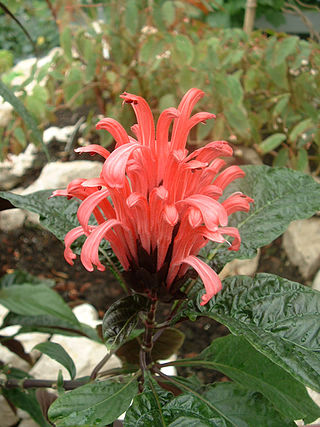
Acanthaceae is a family of dicotyledonous flowering plants containing almost 250 genera and about 2500 species. Most are tropical herbs, shrubs, or twining vines; some are epiphytes. Only a few species are distributed in temperate regions. The four main centres of distribution are Indonesia and Malaysia, Africa, Brazil, and Central America. Representatives of the family can be found in nearly every habitat, including dense or open forests, scrublands, wet fields and valleys, sea coast and marine areas, swamps, and mangrove forests.

Vanda, abbreviated in the horticultural trade as V., is a genus in the orchid family, Orchidaceae. There are 90 species, and the genus is commonly cultivated for the marketplace. This genus and its allies are considered to be among the most specifically adapted of all orchids within the Orchidaceae. The genus is highly prized in horticulture for its showy, fragrant, long-lasting, and intensely colorful flowers. Vanda species are widespread across East Asia, Southeast Asia, and New Guinea, with a few species extending into Queensland and some of the islands of the western Pacific.

Justicia is a genus of flowering plants in the family Acanthaceae. It is the largest genus within the family, encompassing around 700 species with hundreds more as yet unresolved. They are native to tropical to warm temperate regions of the Americas, India, and Africa. The genus serves as host to many butterfly species, such as Anartia fatima. Common names include water-willow and shrimp plant, the latter from the inflorescences, which resemble a shrimp in some species. The generic name honours Scottish horticulturist James Justice (1698–1763). They are closely related to Pachystachys.

Acanthus is a genus of about 30 species of flowering plants in the family Acanthaceae, native to tropical and warm temperate regions, with the highest species diversity in the Mediterranean Basin and Asia. This flowering plant is nectar producing and is susceptible to predation by butterflies, such as Anartia fatima, and other nectar feeding organisms. Common names include Acanthus and bear's breeches. The generic name derives from the Greek term ἄκανθος (akanthos) for Acanthus mollis, a plant that was commonly imitated in Corinthian capitals.

Ruellia is a genus of flowering plants commonly known as ruellias or wild petunias. They are not closely related to petunias (Petunia) although both genera belong to the same euasterid clade. The genus was named in honor of Jean Ruelle (1474–1537), herbalist and physician to Francis I of France and translator of several works of Dioscorides.
Aphelandra schottiana is a species of flowering plant in the family Acanthaceae. It is a shrub native to eastern and southern of Brazil. This plant is cited in Flora Brasiliensis by Carl Friedrich Philipp von Martius.
Aphelandra longiflora is a species of flowering plant in the family Acanthaceae. It is native to Brazil, Bolivia, and Misiones Province of northeastern Argentina.

Dicliptera is a genus of flowering plants in the bear's breeches family, Acanthaceae. Well-known synonyms include Peristrophe and Dactylostegium.

Ruellia simplex, the Mexican petunia, Mexican bluebell or Britton's wild petunia, is a species of flowering plant in the family Acanthaceae. It is a native of Mexico, the Caribbean, and South America. It has become a widespread invasive plant in Florida, where it was likely introduced as an ornamental before 1933, as well as in the eastern Mediterranean, South Asia and other parts of the eastern hemisphere.

Poikilacanthus is a genus of flowering plants in the family Acanthaceae.

Lepidagathis is a genus of flowering plants in the family Acanthaceae. It includes 151 species native to the tropics of the Americas, sub-Saharan Africa, south and southeast Asia, southern China, Malesia, and New Guinea.

Stenandrium is a genus of flowering plants in the family Acanthaceae native to the Americas, with 50 species of perennial herbs ranging from the southern United States to northern Argentina and central Chile.

The genus Asystasia belongs to the family Acanthaceae and comprises 59 species found in the tropics of Africa, Asia, Australia, and New Guinea. It includes the weedy species Asystasia gangetica.

Odontonema, the toothedthreads, is a genus of flowering plants in the family Acanthaceae. It is native to Central America.

Pseuderanthemum is a genus of plants in family Acanthaceae with a pantropical distribution.

Stenostephanus is a genus of plants in the family Acanthaceae.
Xantheranthemum, known as the golden vein plant or bronze vein plant, is a genus of flowering plants in the family Acanthaceae. It has only one currently accepted species, Xantheranthemum igneum, native to Peru. It is grown as a greenhouse or house plant. There may be some confusion caused by the names of the botanists Linden and Lindau, as some sources associate it with Aphelandra goodspeediiStandl. & F.A.Barkley, along with Chamaeranthemum igneumRegel, Eranthemum igneumLinden, Stenandrium igneum(Linden) André, Stenandrium pictumN.E.Br., and Xantheranthemum igneum(Linden) Lindau.
Chamaeranthemum is a genus of flowering plants belonging to the family Acanthaceae.
Herpetacanthus is a genus of flowering plants belonging to the family Acanthaceae.















